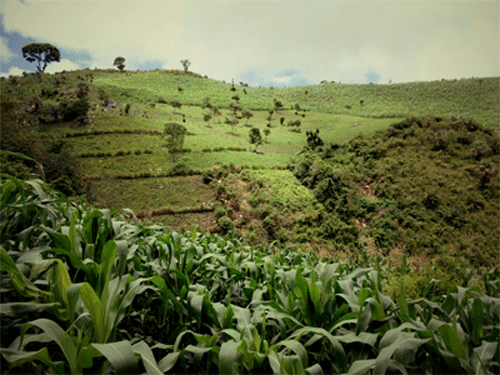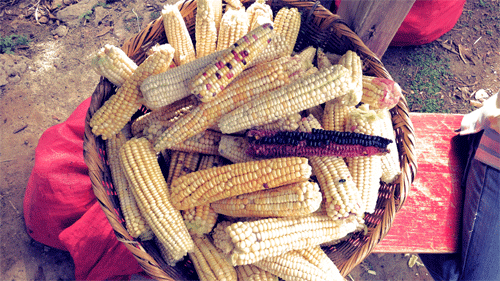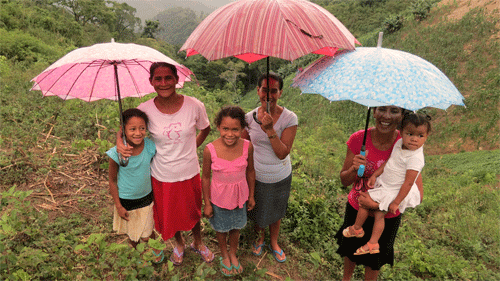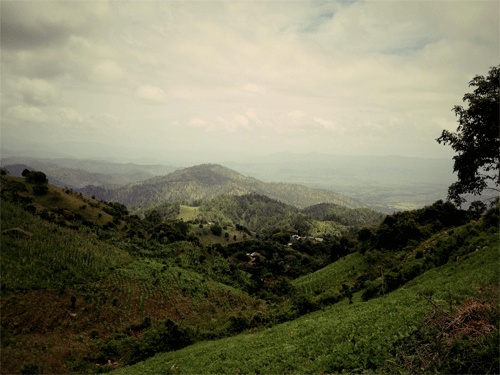
The release of Hey Rosetta's Juno- nominated album Seeds triggered a connection between lead singer Tim Baker and USC Canada's global Seeds of Survival program. Taking a "break" from the band's busy touring schedule, Tim recently travelled with USC into the mountains of Honduras to see the seeds and the food sovereignty work being done down there. Here's what he wrote about it...
I leave Montreal through the early morning dark, and only a few of hours later land in a completely different world. The hot, loud, yellowing airport at San Pedro Sula is much smaller than expected. Smaller even than the airport of my native St John's, despite San Pedro's population being nearly tenfold. The explanation is pretty apparent as we begin driving away from the city into the distant mountains: almost nobody can afford to fly. We don't go into the city, about which I'm seriously relieved. I did a little reading before we left, and it seems San Pedro Sula is the most dangerous city in the world, with around 2,000 homicides per year. For perspective, if New York City was as dangerous, there would be about 13,000 murders a year, where there are actually less than 500. So, I breathe a little easier as we head away from the "aeropuerto" and off into "el campo."
Though the breath still catches. Most of the buildings and vehicles we pass are crumbling and cobbled together. The view out of the truck starts to take on the repetitious quality of looped landscapes in old cartoons: hungry dog, barefoot kids, man on bicycle, pulpería (corner store) with giant Pepsi sign, scattering chickens, tired men perched perilously high in trucks full of bananas or sugar cane, hungry dog, barefoot kids, man on bicycle, Pepsi pulpería, etc. The loop varies little during our four-hour climb into the mountains.
Our driver, Ernesto, keeps breaking into song and egging me on to join him. Of course I don't know any of the music, but I eventually give in and start sort of scatting and wailing Spanish-sounding words, which I worry he might find offensive, but in fact he thoroughly enjoys. My Spanish is a little stronger than I thought and I'm understanding about half of what Ernesto is saying (and elaborately gesturing) about the land and the farms we pass. Here is sugar cane, and more and more neverending sugar cane. All of this incredibly fertile valley is basically sugar cane, or bananas, or corn -- mostly owned by multinational fruit companies.
Ernesto says that most of these fertile plains were cheaply bought or simply expropriated and taken from small farmers over the last hundred years. He shakes his head, suddenly serious. As we climb higher and higher into the mountains we can see where many of these farmers have ended up. Corn, bean and coffee fields arc up unbelievably steep slopes. Over the next few days our legs will get to know these angles well. And our admiration will swell for the those leaning upon them.

Through the corn and up the hill.
Our first visit is to the tiny mountain village of La Esperanza. I love this place, the people there, the name. But before we get to all that, you'll have to bear with me. There's a stack of acronyms, a cast of characters, and a bunch of agricultural know-how I need to share first.
The farmers in La Esperanza have organized into a CIAL (basically a Local Agriculture Research Cooperative). They have been brought together by the Honduran organization FIPAH (Foundation for Participatory Research with Honduran Farmers) who've adopted and adapted the CIAL methodology from CIAT (International Centre for Tropical Agriculture).
FIPAH is backed by the Canadian NGO that brought me along, USC Canada (which used to stand for Unitarian Service Committee, but isn't actually associated with Unitarianism anymore -- although Unitarianism looks kinda awesome). FIPAH is linking up agronomists (people who study agriculture) with farmers (people who practice and, well, also study, agriculture) to advance the science of plant breeding, and more importantly to get more food on the tables of remote communities like La Esperanza. This cooperative study by scientists and farmers is known as Participatory Plant Breeding (or PPB), and that's the last of the acronyms, promise.
Most of the farmers that we met told us that before FIPAH, they didn't know very much about selecting which seeds to save for the next planting. They would simply choose the biggest kernels from the largest cobs of corn, or the biggest, best looking beans or seeds. But now they know to look at the plants too, and their position in the field when selecting seed. And they've learned to look at seed selection and plant breeding as a much more integral part of farming. Now they are only selecting seeds from healthy plants with high yields -- plants with leaves and fruit that are resistant to pest & disease.
And they look at the plant structure: Will this corn be too tall, too easily blown down by a strong wind? Is this bean plant too viney? The bushier bean plants suffer less rot in wet weather, are easier to weed, and won't strangle corn or trees planted among them. It's only after several specific and holistic criteria are met that they then select the biggest, best-looking seeds.
Then begins the more scientific stuff: cross-pollinating and hybridizing different strains of desired plants to make even better, healthier, higher-yielding varieties with more appropriate structures and strengths. It's apparent immediately that a single variety of corn developed by a bio-tech company for the flat, fertile, heavily mechanized mid-west will fail on this terrain, under this weather, and within this economy. So the PPB focuses mostly on combining traditional "land races" (local, ancient, adapted varieties) with other successful varieties developed by agronomists and farmers elsewhere.

Maize Basket
FIPAH has also been reintroducing farmers to the "Milpa" system: an ancient Meso-American system of growing lots of different plants in the same space. It's very unlike our European tradition of pristine, parallel rows of monoculture. So much so that it often strikes you, as you are sweating through it, possibly covered with ants, as being "messy" or "wild" or "not even agriculture at all."
But, once again, "indigenous" and "ingenious" sound strangely similar, and Milpa is perfect for the climate and terrain of Honduras for many reasons. Planting a variety of crops, and rotating them season to season, will help to keep the soil balanced and rich (for example, beans release nitrogen into the soil, while corn depletes it). And planting trees throughout a field can work all kinds of wonders: they create moving shade from the blistering equatorial sun, they retain soil during heavy rain (a huge problem with this steep terrain and long, torrential rainy season), they provide traditional medicine, wood (THE fuel of the countryside -- wood accounts for over 80 per cent of Honduran energy), as well as fruit, nuts, and legumes to make up a balanced diet.
But the real genius of Milpa diversity is its security. As different plants all mature at different rates throughout the long two seasons -- rainy and dry -- harvests remain constant, staggered, and fresh. And most importantly, even if a pest, disease, or hurricane sweeps through the countryside and decimates a particular crop, the people of La Esperanza will still have enough other crops so that they will no longer experience "Los Junios" (traditional weeks of hunger in June) ever again.
Pretty obvious why I like the name of the village then, literally Spanish for "The Hope": it's a bit too perfect. We are gathered there, talking as the sun sets. The men are softly laughing about "Los Junios" ever existing. The women are under bright umbrellas, proudly describing their recent discovery of field work, bean science, and their own blooming self-confidence. The young man, Jesus Herrera, is confessing his former plans to move to the city, before the CIAL's success and the sudden promise of his father's farm. We hear distant squeals of kids younger, playing soccer in the valley grass below.
La Esperanza has quintupled its bean yield since they adopted (and continue to refine) FIPAH's methods. Each harvest gets better and better, systematically. This control and this hope echoes into the lives of all these people. I can feel it myself. It's much more than food. Because, really, food is more than food. It's possibility. There is no science, or art, or math, or music, or creativity when you're starving. There is no innovation, no dancing, no jokes, no books, no systematic improvements, no sex, no architecture, no love, no life without food. If you don't mind an obvious analogy, it's like food is the seed, and the fruit is what we know as life. What we know as the daughters of La Esperanza blushing, hushing up as the camera passes. As the scratchy merengue coming from the dusty truck. The rooster whoop. The gleaming sun. Another softly offered plate of rice and beans.

Women of La Esperanza
After La Esperanza, we visit other CIALs, and are welcomed just as warmly. We go to Agua Sucia, where we meet Adan Bustillo, a farmer who's overcome a worrisome blight in the region by creating an organic fungicide using a "good" fungus he noticed protecting trees in the nearby woods. He's also introduced a new organic fertilizer that incorporates grinding up small iron-like mineral deposits found in the hills of his farm! We go to Santa Cruz, where we hear again the fears of genetically-modified corn taking over, killing their "land races" and the new improved varieties they've helped create. Nobody we meet wants anything to do with chemical sprays, fertilizers of "transgenicos." They've seen men who spray develop cancer and die. They've seen the northern varieties fail. And they're beginning to see the power of biodiversity. As a man strolling past on the dusty mountain road asserts: "A lot of people put down organic agriculture in Honduras, but the earth tells us the truth. Nature is our greatest ally."
Near the end of our Santa Cruz visit, we meet with a Youth CIAL there, and have our minds blown entirely. School stops at grade nine here in the countryside, but all these kids want to finish high school. So together they work a plot of land, purchased with a loan from FIPAH. They plant, weed, study, and harvest their rocky plot using the PPB and Milpa systems. With it, they help feed their families (many of them have children) and sell what they can at nearby markets or to the traveling "coyotes" or middlemen.
They pool this money, reinvest in their farm, and use the rest to order away for books and tapes from the Instituto Hondureño de Educación por Radio, a high school education-by-radio program. Not exactly the same skip-class-smoke-oregano-steal-yer-parents-liquor-throw-up-in-the-bushes-and-pass-out-under-the-bleachers kind of high school I remember. But they are fun kids still. They are, in short, short and incredible human beings.
Later that evening, shell-shocked and sun-burnt, we are sitting around Doña Nelba's table, finishing our syrupy coffee and asking her about herself. She cooks all our meals. She is friendly, middle-aged, entrepreneurial. Seriously entrepreneurial. She has a business making a special organic fertilizer called "bocachi." She has a water filtration and delivery business that employs only women. She grows and sells ornamental flowers. She is a CIAL member. She is a seamstress. She is running for mayor. And she is a single mother of six. Only her two daughters remain here in Yorito with her. She has two sons working in the United States, two studying in Honduran cities. She worries about them. Several years ago one of her sons was murdered by a gang in San Pedro Sula. We stop chewing. She seems pretty relaxed, but you can tell she wishes her children were all still at home in the moderately safe countryside. Though, shrugging, she goes on to tell us that only a few days earlier a bus leaving Yorito was stopped nearby and boarded by men with machine guns, and everyone was robbed. Our beans and bananas catch in our throats.
All over Latin America, all over the "Global South", young people are leaving the countryside and heading toward cities in search of a better life. But often what they find is far less desirable than what they left behind. And what they left becomes older and older people tending steep fields, trying to feed themselves. The next day, speaking with José Jimenez, the founder of FIPAH, we learn that the Honduran government does not offer support or credit to small farmers, or invest in any meaningful rural development. I assume they're not interested in sustainable subsistence farming with all the instability of a gang-run city and the next coup waiting just beyond their office windows. So it's against this backdrop, to say nothing of the constant fearful uttering of "Cambio Climatico" (climate change), that the work of FIPAH (and of the NGOs like USC that support it) comes into focus. And that the small, dynamic, cooperative approach that steers this work begins to seem like a larger, more important, more global solution than it first appears. Again, like a seed, even. Like a well-suited, deliberately selected seed.
Like most people, I've never been much of an activist. I'm a bit of a waffler -- I generally apply a sort of distracted scrutiny to all sides and then still feel too uninformed to commit to either. Which is maybe why I've gravitated towards food security. It's an issue without much debate, in my mind. A couple indisputable ideas: Everyone should have enough to eat. And what they have should be as healthy (obviously) and delicious (why not?) as possible. Plus a sort of implied corollary: "Everyone" includes people of the future, so destroying farmland and biodiversity is not really an option. So debates around genetic modification, chemical pesticides/herbicides/fungicides, synthetic fertilizers, large-scale monoculture and many other industrial farming practices don't seem that tricky to me.
These are technologies that increase efficiency and profitability, but only for those who can afford them, and often ignoring health, security, and our tenets above. They are technologies a little too reminiscent of the bottom dragging trawlers that decimated the cod stocks, economy, and culture of my home province decades ago. They are powerful, awkward, and dangerous, and they are controlled by people who merely have capital and want more. In fact, I haven't really encountered many "debates" around sustainability at all. More like a few large corporations and their PR firms saying one thing, usually with government departments behind them (revolving doors a-swingin'), and literally everybody else either fervently against or blissfully (though maybe a little biliously) ignorant.
I was hoping to make this essay (the first I've written in nearly as decade!) a lot shorter, and more colourful, and larger in scope. But soon after starting, I realized how important specifics are. It's pointless to think in generalities. And hard. For some reason I have enough to eat (too much usually), I live in a safe-ish neighbourhood, enjoy (well not really enjoy) health care, and have enough money to avoid ruin. Then there are billions (billions!) of people for whom that is a sharp and faraway dream. The world is fucked up and unfair. How do I help faceless billions, a number I can't even conceive of?
These are daunting, depressing, and impassable thoughts. Impractical. And practicality is what is needed most. The solutions to so many of the problems throughout the global south are like the solutions I've witnessed here: tangible, sensible, flexible, local. A new variety of corn that can better withstand the wind. A new kind of bean that resists "bean rust."
A row of avocado trees at the crest of the hill. Not food aid or handout or dug well (not to belittle such good intentions) but instead the knowledge to keep refining and improving with each passing day. Teaching a man to fish as they say. Or more aptly, teaching (and learning from) men and women and children how to farm, smarter. To farm smarter, to live better, with confidence and control over their own land and lives. To have everyone perching, for a moment, in the sun-baked dirt, on the upward slanted slope of "The Hope."

Perched on The Hope.